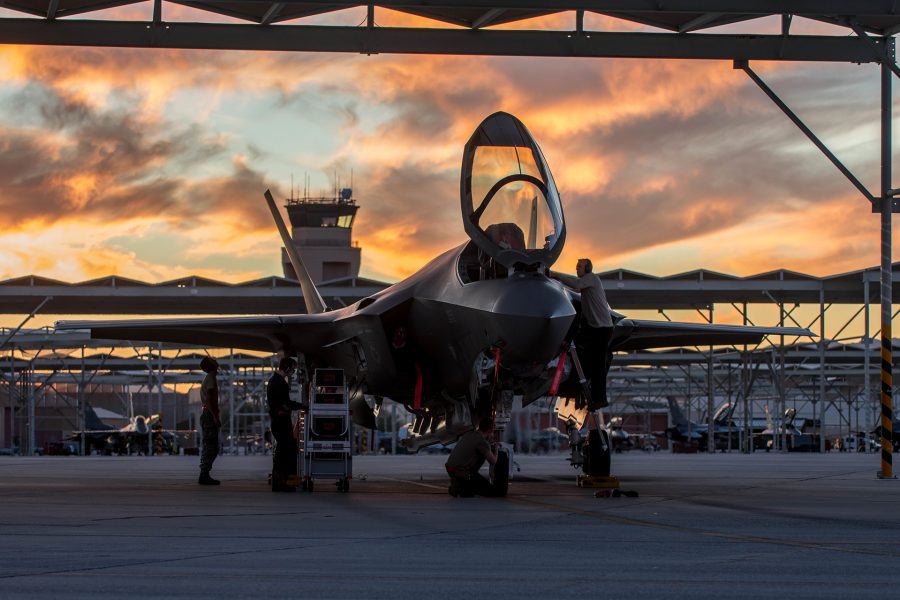It could take until the end of the year to fully cut Turkey out of the F-35 program, Pentagon acquisition and sustainment chief Ellen Lord said Jan. 14.
“The majority of our supply chain will be out of Turkey by March,” Lord told defense reporters in Washington, D.C. However, Lockheed Martin and Pratt & Whitney, the airframe and engine maker of the F-35, respectively, have “contracts that may carry out to the end of the year” with Turkey, Lord said. She added only that the Pentagon is managing the “unwinding” of that country’s involvement in the program “to minimize impact to production.”
There’s been no discussion with Ankara about the disposition of four F-35s owned by Turkey that are in the US, of which Lord herself has said will not be delivered to Turkish soil.
The F-35 partners agreed to eject Turkey from the F-35 program over that country’s decision to buy and field the Russian S-400 Triumf air defense system. Lord reiterated that the two systems are incompatible, saying Russian technicians could learn too much about the F-35 from operating the S-400 in close proximity to the fighter, and Turkey is intransigent about cancelling the purchase and deployment of the S-400.
The F-35 is a “computer in the sky that talks to all the other US assets,” in the air and on the surface of the Earth, Lord explained. The S-400, she revealed, “is a system that collects information on that. We will not allow one of our most precious assets to be collected-on on a routine basis.”
Some countries have complained that the S-400 is more advanced and cheaper than the US offering, the Patriot, but Lord dismissed those complaints as commercial disgruntlement.
“When the two are compared, quite often our Foreign Military Sales customers want an enormous amount of technical data transfer, and they want significant in-country production capability.” While that may be “feasible” with some of the less-sensitive aspects of the system, the US is “constrained” by the International Traffic in Arms Regulations.
“Quite often, the appetite cannot legally be satisfied,” she said of Patriot customers. “That sometimes gets confused in the S-400 discussion.”
Lord said her office, and others in the Pentagon, continue to evaluate an unsolicited proposal from Lockheed Martin to undertake a Performance-Based Logistics contract for the F-35 fleet that the company claims would get operating costs on the jet to $25,000 per flight hour by 2025.
“We have been working since last fall” to “decompose” the costs of operating the F-35 to understand them better and make a meaningful evaluation of whether PBL is the way to go, Lord said. She added that the Pentagon has “outside consultants to help us with that, to make sure we have independent points of view,” and that one of those evaluations will be briefed at the end of this week.
Lord said she’s seen PBL contracts that are “very effective and efficient, … a win for industry and government,” but that it’s too soon to make such a judgement with the F-35. “We need clarity on cost and intellectual property issues,” she said.
The F-35’s cost per flying hour is now about $35,000, and while Lord said she has a “line of sight” to a cost of $29,000, she doesn’t have one to $25,000, yet. The US won’t be able to “afford as many planes as we have planned unless we get that cost per tail per year down,” she added.
No cost-cutting moves are planned to disband the F-35 System Program Office and turn management over to the separate services, as is being discussed on Capitol Hill this week, Lord reported. She delivered a congressionally mandated study two years ago to look at the issue, but the bottom line hasn’t changed, she said.
“For right now, the JPO is absolutely critical” to the program because of the international partner and FMS component. She also said the program is mostly staffed by Air Force, Navy, and Marine Corps officers already.
As the program matures, though, management will migrate to the field, “because that’s where the action is.” While the F-35 is still very much in development—the Block 4 updates are “very complex” with “challenging technology”—over time, “the JPO will diminish in size as the services take on more responsibility, especially as we stand up the depots.”
Lord said the program is “in a transition, where sustainment becomes just as important as development.”

